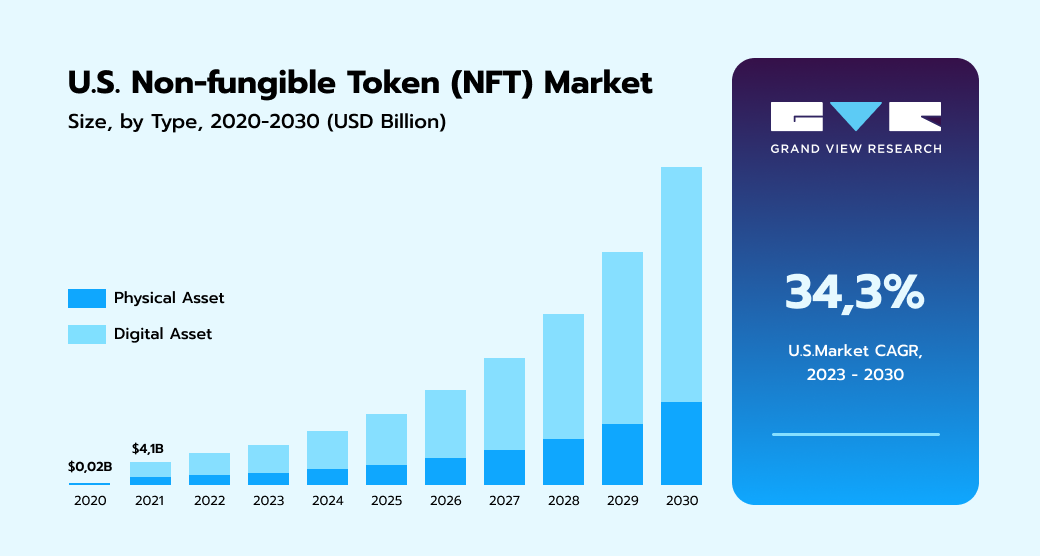In 2025, the media and entertainment industry will adopt digital transformation on an unprecedented scale. AI is everywhere — its anticipated effect on the media and entertainment industry is estimated by a PwC report to be $15.7 trillion by 2030. Direct-to-consumer services, personalized content, gamification, and other trends are not just cool new technologies. These approaches are reshaping how younger demographics — and even older audiences — expect the media industry to keep them engaged. After all, in today’s world, it’s not just about what’s being shown; it’s about how it’s experienced. As they say, “If you’re not keeping them entertained, you’re losing their attention.” Interested yet? Keep reading to learn about the media and entertainment trends that will start or continue shaping the future of the industry in the year to come.
The continuous rise of streaming and OTT platforms
The media and entertainment industry has been fundamentally disrupted by the rise of streaming and Over-The-Top (OTT) platforms, which have transformed content consumption and distribution. While traditional cable TV struggles to retain subscribers, the dominance of streaming giants continues to grow. Platforms like Netflix, Amazon Prime Video, and Disney+ maintain an unrivaled presence in global markets. These services appeal to diverse audiences with customizable libraries and flexible subscription options tailored to meet any consumer’s needs.
What motivates this trend even further is the growing popularity of on-demand content. Modern consumers are seeking flexibility. They want to watch whatever and whenever it feels right for them, without the constraints scheduled programming puts them in. Netflix has been able to achieve this by using elaborate algorithms that can recommend specific content to viewers, based on their viewing behavior. Amazon Prime Video bundles its streaming services with e-commerce benefits, increasing value beyond entertainment.
Disney+ has taken a unique approach, capitalizing on its Marvel and Pixar intellectual property while introducing original hits like The Mandalorian to attract subscribers. The strategy has been wildly successful! In the first two years since the launch of the service, it gained more than 116 million subscribers. It also bundled strategically with ESPN+ and Hulu to assemble a wide-reaching content ecosystem for sports enthusiasts and adults alike.
Regional OTTs are also growing
The growth of regional OTT platforms will be an important sub-trend in media and entertainment in 2025. For example, Hotstar in India and iQIYI in China have already made a strong mark in offering their services in local languages and preferences. The platform viewers were very engaged by the tailored material. It means the localization strategies enabled them to have quite a loyal user base, as now their monthly visitors number are around 35 million users. This loyalty further increases the competitive scenario in the global streaming market.
With streaming services gaining momentum, attention will fall on innovative formats such as interactive content. For instance, “Bandersnatch” from Netflix is changing how audiences interact with digital entertainment.
 eSports broadcasting is here to stay
eSports broadcasting is here to stay
The landscape of eSports broadcasting is rapidly expanding, with the global eSports audience projected to reach 577.2 million by the end of 2024. Twitch, YouTube Gaming, and Facebook Gaming have thus far been giants in this arena, hosting tens of millions of viewers and raking in hundreds of millions of dollars from ad revenue, sponsorships, and media rights. In 2021, eSports revenues eclipsed $1.1 billion, with media rights and sponsorships contributing over 75% of the total.
One of the key trends to watch in 2025 is the continued rise of mobile eSports, particularly in emerging markets like Latin America and Southeast Asia, which are becoming major hubs for this trend. The growing popularity of mobile gaming has been a significant driver, pushing the global streaming audience toward the billion mark. This growth is accompanied by the increasing professionalization of eSports broadcasting. Top tournaments, such as the League of Legends World Championship and The International, now feature high-quality productions with multiple camera angles, real-time statistics, and professional commentators as standard elements.
Interactivity is also an integral part of the experience for eSports viewers. Online platforms now offer real-time chats, audience polls, and exclusive content, with community features becoming more sophisticated.As eSports continues to grow, traditional broadcasters such as ESPN and NBC increasingly include eSports in their offerings. This is a testament to the rapid development of this important global sports entertainment segment.
 Immersive content with AR, VR, and the Metaverse
Immersive content with AR, VR, and the Metaverse
Emerging immersive technologies like AR, VR, and the Metaverse are new ways for audiences to entertain themselves. Companies like Niantic have reinvented the rules of engagement in gaming with Pokémon GO by seamlessly merging physical and digital experiences. Meanwhile, the industry leader, Walt Disney is taking a different approach, utilizing VR to offer virtual theme park tours, allowing guests to remotely experience attractions.
Media and entertainment companies are increasingly pushing for an interoperable digital space where users can socialize, attend virtual concerts, and participate in interactive storytelling experiences. Meta’s Horizon Worlds and Roblox were considered among the pioneers; major studios use the Metaverse to hold virtual movie premieres and interactive events. Major film studios use the Metaverse for virtual movie premieres and other forms of interactive events. Warner Bros. has already been considering digital spaces to deepen engagement.
This trend will change the very way audiences experience entertainment. Investors like Microsoft, Sony, and Epic Games are focusing on immersive content that will turn passive consumption into active participation.
 Personalized experiences through AI and big data
Personalized experiences through AI and big data
Big data and Artificial Intelligence have changed how media and entertainment companies engage with their audiences. Media platforms analyze data on audiences based on personal, demographic, and behavioral grounds. With all the above in mind, they can assemble a detailed profile of the user’s preferences, habits, and needs.
For instance, Netflix bases its customized recommendations on subscription data, demographic information like age and sex, and viewing behavior, inclusive of watch time. This level of personalization is a big reason it boasts an industry-leading 72% customer retention rate.
Companies that rely on Direct-to-Consumer (DTC) and Ad-Supported Video on Demand (AVOD) models are increasingly leveraging AI to better segment audiences, improve ad targeting, and optimize content creation for distinct user groups. AI-driven audience insights enable platforms such as Hulu and Amazon Video to make smarter choices with content investments. It ensures that they’re investing in shows and genres that align with consumer demand.
AI is also increasingly being used in monetization tactics, where it finds potential for dynamic pricing and customized subscription packages. Big data will remain the primary tool for creating highly personalized experiences that go beyond simple content recommendations as media consumption becomes more dispersed. Predictive algorithms based on this technology will eventually be able to forecast what consumers will want to watch next — even before they become aware of it.
 NFTs to become a part of user experience
NFTs to become a part of user experience
Blockchain technology has introduced a new era in handling digital ownership through the introduction of NFTs. These assets are unique and verifiable digital ownership that can safely be traded on the blockchain. From virtual event tickets to digital art and collectibles, non-fungible tokens have taken different forms. This technology gives artists, athletes, and content creators the ability to tokenize their work. At the same time, they can create opportunities for fan engagement and monetization.
One of the most intriguing uses of NFTs is in virtual events and ticketing. Unlike traditional tickets, NFTs can be programmed to include additional perks such as VIP experiences, exclusive content access, or the ability to resell tickets on secondary markets. This approach not only helps prevent counterfeiting but also creates long-term value for both buyers and sellers. NFTs can be applied to limited-edition digital tickets, serving as both memorabilia and secure entry passes for live events.
NFTs have also started to find their place within the art and collectibles market. Iconic sales, such as those of the Nyan Cat, Jack Dorsey’s first tweet, and even some of William Shatner’s memorabilia, prove that digital items hold a lot of value. NFTs offer proof of ownership and authenticity by utilizing the security and transparency of blockchain technology. Overall, they’re perfect for protecting the value of digital art.

As this trend gains momentum, NFTs are expanding into even more creative applications, such as in-game items, virtual real estate, and exclusive merchandise drops. With leading platforms and artists exploring these avenues, blockchain and NFTs are poised to reshape digital asset ownership and fan engagement.
 Interactive content and gamification
Interactive content and gamification
Interactive content and gamification are revolutionizing brand interaction with audiences. They’re doing so by making consumption participatory. Gamification incorporates game-like elements that reward users with points, badges, and leaderboards. Such elements encourage users to get more involved and stay for longer stretches. Companies like Nike and Duolingo stand as examples: Nike’s fitness challenges and Duolingo’s daily streaks provide a sense of achievement and improve audience engagement.
Other forms of interactive content, including quizzes, polls, and augmented reality (AR) features, allow users to create memorable and personalized experiences. For instance, IKEA’s AR app enables customers to visualize how furniture will look in their homes, offering a more interactive and practical shopping experience. These interactive techniques help companies create more immersive experiences for their users.
When applied well, gamified experiences build community. Sites like Duolingo incorporate leaderboards and social sharing options to foster a competitive-fun environment through which users share their progress. This combination of motivation and interaction gradually forms a better customer experience and brand loyalty. That being said, gamification is a strategic differentiator for companies adapting to changing customer expectations.
Interactive content, blended with gamification, is more than just one of the media and entertainment industry trends. It is turning into the inseparable weapon of differentiation for every media and entertainment company striving to provide more immersive experiences.
 Social media again and again, and again
Social media again and again, and again
Social media has evolved into a massive, unified distribution platform, making immediate global reach highly feasible for both brands and creators. Instagram, TikTok, and YouTube are no longer just channels of communication. These hugely popular platforms are dynamic ecosystems where content gets created, shared, and monetized. That is the power of social media: amplification of reach through sharing, comments, and going viral helps the content go exponential.
One notable shift is the increasing focus on video content. Short-form videos on TikTok and Instagram Reels are becoming a medium of choice to reach younger demographics, while YouTube remains strong for longer-form and educational content. This versatility gives brands the license to create content that best fits their audience preferences.
Additionally, influencer partnerships have become one of the cornerstones of social media distribution. Partnership with an influencer helps a brand reach some of the very specific communities out there. It makes sure content reaches highly engaged followers who also trust the digital personality.

Entertainment and media industry is going green
There is an increasing trend in adopting sustainable production methods within the media and entertainment industry. It is driven by the growing consumer demand for greener working methods and climate change. According to Deloitte’s 2023 sustainability report, 34% of global consumers would be more likely to trust brands that are committed to sustainability. This trust directly influences consumer spending and purchasing decisions. Major industry players like Sky and the BBC have set ambitious sustainability targets, with Sky aiming for net-zero carbon emissions by 2030, while the BBC has implemented sustainable strategies across its broadcasting operations.
These actions are not just ethical but also economically pragmatic. Unprecedented weather events and rising temperatures have disrupted filming schedules, increased logistical costs, and thus called for sustainability as a business continuity concern. Companies now leverage innovations such as AI-powered energy management, modular set designs, and renewable energy sources to reduce their ecological footprint.
According to Deloitte, production sustainability may dramatically lower operational expenditure. Natural air cooling in data centers can decrease energy consumption by 30%, while next-generation low-power equipment, such as low-power 5G, reduces carbon emissions by up to 94% during low-traffic periods. By adopting these practices, companies can balance their sustainability goals with long-term profitability.
What lies ahead for 2025 and beyond
In 2025, the media and entertainment industry will gain momentum like never before. Video content, social media platforms, traditional broadcast, and cable TV are just a few major areas that have experienced incremental changes. We can’t emphasize this enough: focusing on your target user and their evolving needs is the primary thing that will motivate the incremental growth of your media and entertainment business. As of 2024, the average person spends at least two hours daily consuming media content, meaning you have to make sure the content is highly targeted, engaging, and unique. After all, if you don’t understand your audience, someone else will.
Would you like to discuss any of the trends above in more detail? Or do you need an expert’s take on how to make the most of any of them for your media and entertainment business in 2025? Contact us!


 eSports broadcasting is here to stay
eSports broadcasting is here to stay Immersive content with AR, VR, and the Metaverse
Immersive content with AR, VR, and the Metaverse Personalized experiences through AI and big data
Personalized experiences through AI and big data NFTs to become a part of user experience
NFTs to become a part of user experience
 Interactive content and gamification
Interactive content and gamification Social media again and again, and again
Social media again and again, and again







